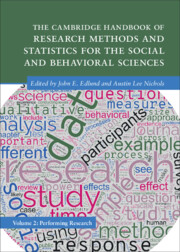 The Cambridge Handbook of Research Methods and Statistics for the Social and Behavioral Sciences
The Cambridge Handbook of Research Methods and Statistics for the Social and Behavioral Sciences Book contents
- The Cambridge Handbook of Research Methods and Statistics for the Social and Behavioral Sciences
- Cambridge Handbooks in Psychology
- The Cambridge Handbook of Research Methods and Statistics for the Social and Behavioral Sciences
- Copyright page
- Dedication
- Contents
- Figures
- Tables
- Contributors
- Preface
- Part I Quantitative Data Collection Sources
- Part II Important Methodological Considerations
- 9 Reliability
- 10 Measurement Validity in the Social and Behavioral Sciences: Some “Whys” and “Hows”
- 11 Statistical Power: How Not to Miss What’s Right in Front of You
- 12 Interdisciplinary and Integrative Research
- 13 The Importance of Replication
- 14 The Inner Workings of Registered Reports
- Part III Self-Report Measures
- Part IV Behavioral Measures
- Part V Physiological Measures
- Part VI Qualitative Data Collection Sources
- Index
- References
9 - Reliability
from Part II - Important Methodological Considerations
Published online by Cambridge University Press: 12 December 2024
- The Cambridge Handbook of Research Methods and Statistics for the Social and Behavioral Sciences
- Cambridge Handbooks in Psychology
- The Cambridge Handbook of Research Methods and Statistics for the Social and Behavioral Sciences
- Copyright page
- Dedication
- Contents
- Figures
- Tables
- Contributors
- Preface
- Part I Quantitative Data Collection Sources
- Part II Important Methodological Considerations
- 9 Reliability
- 10 Measurement Validity in the Social and Behavioral Sciences: Some “Whys” and “Hows”
- 11 Statistical Power: How Not to Miss What’s Right in Front of You
- 12 Interdisciplinary and Integrative Research
- 13 The Importance of Replication
- 14 The Inner Workings of Registered Reports
- Part III Self-Report Measures
- Part IV Behavioral Measures
- Part V Physiological Measures
- Part VI Qualitative Data Collection Sources
- Index
- References
Summary
This chapter is concerned with reliability as a key indicator of measurement quality in behavioral and social science research. It commences with a discussion of the basics and a definition of the reliability coefficient. The following section deals with the meaning, interpretation, and utility of the reliability concept. Subsequently, the focus is on the evaluation of reliability as well as its discrepancy from the popular coefficient alpha that has been widely used for a number of decades as an index related to reliability. The large-sample behavior of the alpha and scale reliability estimates is then discussed, as is the relationship between the reliability coefficient and that of standardized reliability. The conclusion points out the limitations of the procedures for reliability evaluation discussed in the chapter.
- Type
- Chapter
- Information
- The Cambridge Handbook of Research Methods and Statistics for the Social and Behavioral SciencesVolume 2: Performing Research, pp. 189 - 210Publisher: Cambridge University PressPrint publication year: 2024
